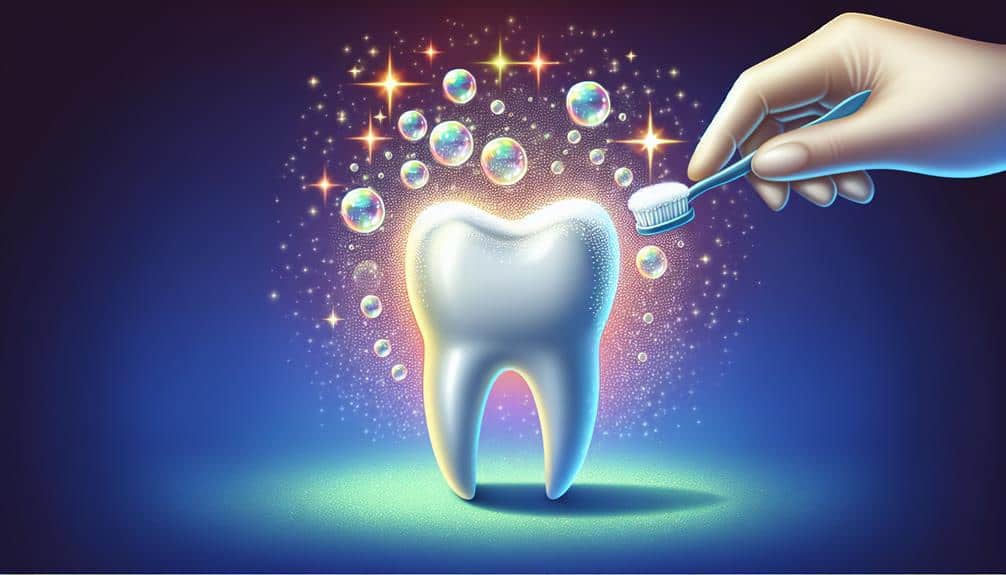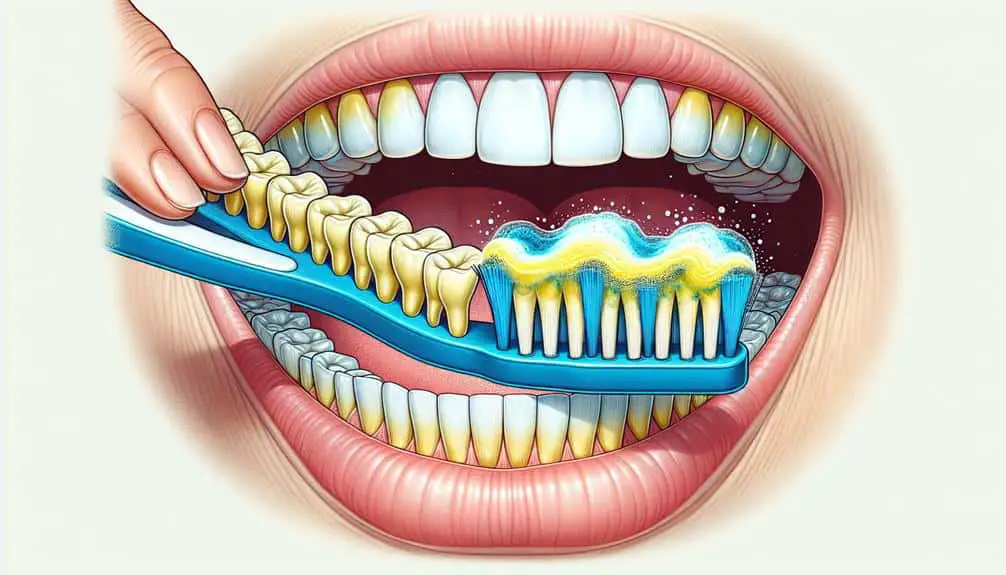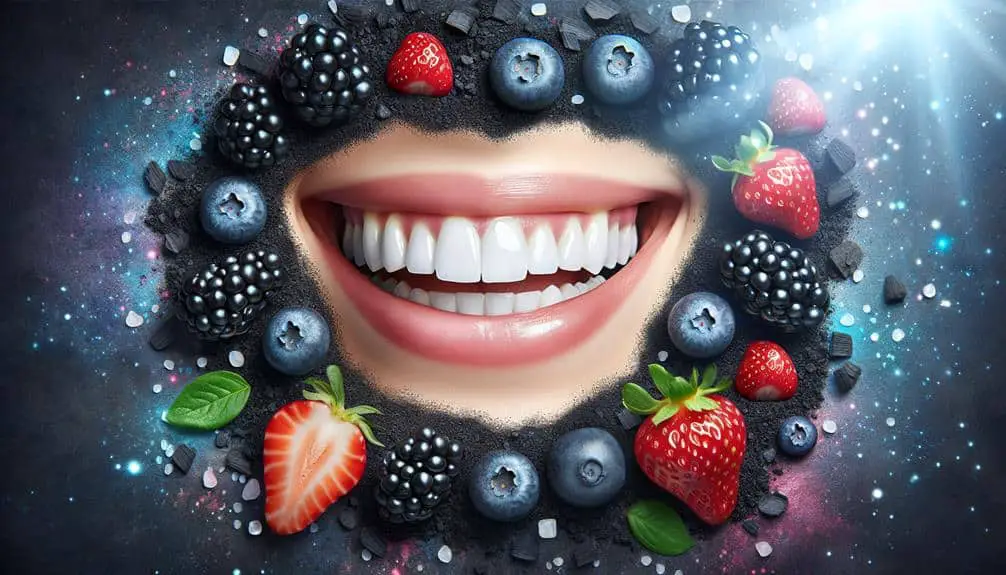For deep fluoride stains, consider professional in-office whitening with chairside bleaching and high-concentration agents. At-home kits with custom trays offer convenience and effectiveness. Laser whitening targets stubborn stains with quick, comfortable treatments. Enhance results with whitening toothpaste and mouthwash for long-term benefits. Explore natural remedies like baking soda and hydrogen peroxide for gentler options. Discover the best whitening techniques for deep fluoride stains to achieve noticeable results.
Key Points
- Professional in-office whitening procedures effectively target deep fluoride stains.
- At-home whitening kits with custom trays provide personalized and convenient solutions.
- Laser teeth whitening is a powerful option for stubborn fluoride stains.
- Whitening toothpaste and mouthwash regimen enhances and maintains whitening results.
- Natural remedies like baking soda and hydrogen peroxide offer cost-effective stain removal options.
Professional In-Office Whitening Procedures
When considering deep fluoride stains, professional in-office whitening procedures offer effective solutions for achieving noticeable results in a controlled environment. Chairside bleaching techniques and power whitening treatments are two common methods employed in these procedures. Chairside bleaching involves the application of a high-concentration bleaching agent directly onto the teeth, which is then activated by a special light to accelerate the whitening process. This technique allows for a quick and efficient treatment, ideal for individuals seeking immediate results.
On the other hand, power whitening treatments utilize a powerful bleaching gel that's applied to the teeth and left on for a specific amount of time. This gel penetrates the enamel to break down deep stains caused by fluoride, resulting in a brighter smile. The supervised environment of a professional dental office ensures that these procedures are carried out safely and effectively, under the supervision of trained professionals who can monitor the process and adjust treatments as needed to achieve best results.
At-Home Whitening Kits With Custom Trays
Utilizing at-home whitening kits with custom trays provides a convenient and personalized approach to tackling deep fluoride stains on your teeth. These kits typically include custom-fitted trays made to fit your teeth precisely, ensuring even distribution of the whitening gel for best results. The custom trays prevent the gel from coming into contact with your gums, reducing the risk of irritation.
One of the benefits of custom trays is their ability to hold the whitening gel securely against your teeth, maximizing its effectiveness. Unlike generic trays, custom trays minimize gel leakage, keeping the whitening agent in constant contact with the teeth surfaces. This feature enhances the whitening process and helps target deep fluoride stains that may be resistant to other methods.
While at-home whitening kits with custom trays offer convenience and personalized application, they may not be as powerful as professional treatments. However, for individuals seeking a cost-effective solution and gradual improvement in fluoride stains, these kits can be an effective option. Additionally, combining the use of at-home kits with professional treatments can lead to enhanced whitening results.
Laser Teeth Whitening for Stubborn Stains
For stubborn stains that require a powerful whitening solution, laser teeth whitening offers an effective and efficient treatment option. Laser technology advancements have greatly improved the efficacy of this procedure by allowing for more targeted and precise treatment of deep fluoride stains. The concentrated light energy emitted by lasers helps break down stubborn stains on the teeth, resulting in a brighter smile.
In addition to its effectiveness, laser teeth whitening also prioritizes patient comfort during treatment. The procedure is typically quick, taking around 30 to 60 minutes, and is performed in a controlled environment by dental professionals. Patients often report minimal to no discomfort during the process, thanks to advancements in laser technology that have made the treatment gentler on the teeth and surrounding tissues.
Whitening Toothpaste and Mouthwash Regimen
To enhance the effectiveness of your whitening regimen, consider incorporating whitening toothpaste and mouthwash into your daily oral care routine.
Whitening toothpaste contains abrasive particles and chemicals that help remove surface stains through gentle polishing. When using whitening toothpaste, it's essential to apply proper brushing techniques to maximize its effectiveness without causing damage to your enamel. Brush gently in a circular motion, ensuring all tooth surfaces are covered. However, be cautious if you have fluoride sensitivity, as some whitening toothpaste may exacerbate this issue.
Mouthwash can complement your whitening routine by reaching areas that brushing may miss. Look for a mouthwash that promotes enamel protection to safeguard your teeth while working on removing stains. Consistent use of whitening toothpaste and mouthwash can contribute to long-term results, especially when paired with professional treatments. Remember, maintaining good oral hygiene practices alongside these products is vital for achieving and preserving a bright, white smile.
Natural Remedies for Fluoride Stain Removal
Consider incorporating natural remedies into your oral care routine to help remove fluoride stains effectively. DIY whitening remedies can be a cost-effective and gentle way to address stubborn stains caused by fluoride.
Baking soda, for example, can act as a mild abrasive that helps scrub away surface stains without being too harsh on your enamel. Mixing a small amount of baking soda with water to form a paste and brushing your teeth gently with it can gradually reduce the appearance of fluoride stains over time.
Another home remedy for stains is hydrogen peroxide. This common household product has bleaching properties that can help lighten stains on your teeth. You can create a mouthwash by diluting hydrogen peroxide with water and swishing it around in your mouth for a minute or two before spitting it out. It's essential to use caution with hydrogen peroxide to prevent irritation or damage to your gums.
Frequently Asked Questions
Are There Any Dietary Restrictions or Habits That Can Help Prevent Further Fluoride Staining on Teeth?
To prevent further fluoride staining on teeth, focus on preventive measures like dietary habits. Avoid acidic foods and drinks that can erode enamel. Opt for water over sugary beverages. Regular dental check-ups are essential for maintaining oral health.
Can Deep Fluoride Stains Be Completely Removed With Whitening Techniques, or Are There Any Permanent Discoloration?
In the domain of dental care, unraveling the enigma of deep fluoride stains can be puzzling. While whitening techniques may diminish these stubborn marks, some cases might disclose permanent discoloration despite all efforts to eliminate them completely.
How Long Do the Results of Professional In-Office Whitening Procedures Typically Last Before Needing a Touch-Up?
To maintain long-term results from professional whitening, touch-up frequency varies based on individual habits. Dental professionals recommend touch-ups every 6-12 months. Home care strategies like using whitening toothpaste and avoiding staining foods can prolong results between in-office visits.
Are There Any Potential Side Effects or Risks Associated With Using Whitening Toothpaste and Mouthwash on a Regular Basis?
When using whitening toothpaste and mouthwash regularly, potential risks include increased tooth sensitivity and gum irritation. Long-term effects may lead to enamel damage. Consult your dentist for personalized advice on maintaining oral health while whitening.
Can Natural Remedies for Fluoride Stain Removal Be Used in Conjunction With Professional Whitening Procedures for Enhanced Results?
To maximize results, combine natural remedies with professional whitening techniques. Enhanced outcomes are achievable through the synergy of these approaches. Natural remedies can complement and boost the effectiveness of professional procedures for best stain removal.



